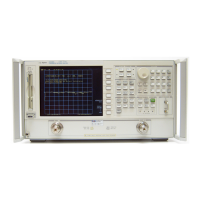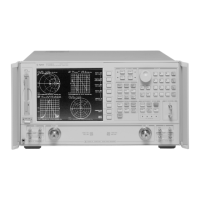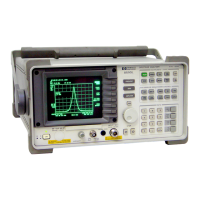Chapter 11 11-3
Error Terms
Error Terms Can Also Serve a Diagnostic Purpose
Error Terms Can Also Serve a Diagnostic Purpose
Specific parts of the analyzer and its accessories directly contribute to the magnitude and
shape of the error terms. Since we know this correlation and we know what typical error
terms look like, we can examine error terms to monitor system performance (preventive
maintenance) or to identify faulty components in the system (troubleshooting).
• Preventive Maintenance: A stable, repeatable system should generate repeatable
error terms over long time intervals, for example, six months. If you make a hardcopy
record (print or plot) of the error terms, you can periodically compare current error
terms with the record. A sudden shift in error terms reflects a sudden shift in
systematic errors, and may indicate the need for further troubleshooting. A long-term
trend often reflects drift, connector and cable wear, or gradual degradation, indicating
the need for further investigation and preventive maintenance. Yet, the system may
still conform to specifications. The cure is often as simple as cleaning and gaging
connectors or inspecting cables.
• Troubleshooting: If a subtle failure or mild performance problem is suspected, the
magnitude of the error terms should be compared against values generated previously
with the same instrument and calibration kit. This comparison will produce the most
precise view of the problem.
However, if previously generated values are not available, compare the current values
to the typical values listed in “9. Uncorrected Port Performance” on page 2-50 and “10.
Uncorrected Port Performance” on page 2-131, and shown graphically on the plots in
this chapter. If the magnitude exceeds its limit, inspect the corresponding system
component. If the condition causes system verification to fail, replace the component.
Consider the following while troubleshooting:
— All parts of the system, including cables and calibration devices, can contribute to
systematic errors and affect the error terms.
— Connectors must be clean, gaged, and within specification for error term analysis to
be meaningful.
— Avoid unnecessary bending and flexing of the cables following measurement
calibration, minimizing cable instability errors.
— Use good connection techniques during the measurement calibration. The connector
interface must be repeatable. Refer to Table 1-3 on page 1-7 for information on
connection techniques and on cleaning and gaging connectors.
— Use error term analysis to troubleshoot minor, subtle performance problems. Refer
to Chapter 4 , “Start Troubleshooting Here,” if a blatant failure or gross
measurement error is evident.
— It is often worthwhile to perform the procedure twice (using two distinct
measurement calibrations) to establish the degree of repeatability. If the results do
not seem repeatable, check all connectors and cables.

